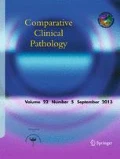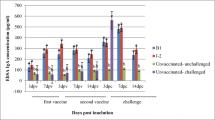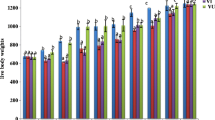Abstract
Few studies have investigated phytogenic gums as vaccine delivery agents in veterinary diseases. This study therefore evaluates the changes in clinical, haematological and histopathologcal responses of broilers vaccinated with infectious bursal disease virus (IBDV) vaccine, administered with the Cedrela odorata and Khaya senegalensis as phytogenic mucoadhesive following experimental infection with virulent IBDV. Two hundred (200)-day-old birds were divided into four groups: as combined gums-IBDV vaccine (A), IBDV vaccine alone (B), gums alone (C) and no gum not vaccinated (D), respectively. The IBDV vaccination was administered ocularly at 14 and 28 days and later challenged with the virulent IBDV at 21 days. All the birds were observed clinically post-infection, blood samples were collected for complete blood count while lymphoid tissues were examined from sacrificed chicks. The haematologic, clinical and lesion score data were descriptively analysed. There were no significant differences in haematological indices except for basophil (p < 0.05). Group A chicks had better immunity with less clinical signs and no lesions in the organs post-infection compared with other groups. Groups B and C had similar clinical signs and histopathological and haematological changes, while in group D, high morbidity with severe clinical signs and lesions were observed. In conclusions, mucoadhesives from phytogenic origin showed potential as delivery vehicle for IBDV vaccines with protection against clinicopathological derangements associated with virulent Gunboro virus.



Similar content being viewed by others
References
Aboki E, Jongur AA, Onu JI (2013) Productivity and technical efficiency of family poultry production in Kurmi local government area of Taraba State, Nigeria. J Agric Sustain 4(1):52–66
Adeniran GA, Ohore G, Jarikre TA, Ola OO, Oyebanji VO, Emikpe BO (2019) Humoral and mucosal immune responses in challengedchickens vaccinated with infectious bursal disease vaccineusing gums from Cedrela odorata and Khaya senegalensis as delivery agents. J Immunoass Immunochem 20(6):630–641
Adeniran GA, Jarikre TA, Ola OO, Ohore G, Oyebanji VO, Emikpe BO (2020) Clinicopathological assessment of infectious bursal disease vaccine using phytogenic mucoadhesive agents in challenged broilers. 46:75–80. https://doi.org/10.5152/actavet.2020.19020
Amakye-Anim J, Lin TL, Hester PY, Thiagarajan D, Watkins BA, Wu CC (2000) Ascorbic acid supplementation improved antibody response to infectious bursal disease vaccination in chickens. Poult Sci 79(5):680–688
Bamaiyi PH (2013) Factors militating against animal production in Nigeria. International Journal of Livestock Research 3 2): 54-66
Canadian Council on Animal Care (CCAC) (2010). CCAC Guidelines on: Euthanasia of animals used in science Published by Canadian Council on Animal care in Science pp 20–22 http://www.ccac.ca
Connolly AJ (2014) A glimpse into the future: a lens through which to consider ‘Africa’s rising. Int Food Agribus Manag Rev 17(B):9–18
Emikpe BO, Oyebanji VO, Odeniyi MA, Salaam AM, Oladele OA, Jarikre TA, Akinboade OA (2016) Ex-vivo evaluation of the mucoadhesive properties of Cerela odorata and Khaya senegalensis gums with possible applications for veterinary vaccine delivery. Springer Plus 5(1289):1–8
Eterradossi N, Saif YM (2013) Chapter 7: infectious bursal disease. In: Diseases of Poultry, 13th Edition, Editor in chief D.E. Swayne, John Wiley & Sons Inc., Ames, Iowa, USA, pp 219–246
Food and Agricultural Organization of the United Nations (2006) Food Aid for Food Security published by Management Services-FAO, Rome
Heise H, Crisan A, Theuvsen L (2015) The poultry market in Nigeria: market structures and potential for investment in the market. Int Food Agribus Manag Rev 18(1):197–222
Jain NC (1986) Veterinary hematology 4th edition published by Lea and Febiger, Philadelphia USA
Kolawole OT, Akiibinu MO, Ayankunle AA, Awe EO (2013) Evaluation of anti-inflammatory and antinociceptive potentials of Khayasenegalensis A. Juss (Meliaceae) stem bark aqueous extract. British J Med Med Res 3(2):216–229
Munira B, Gururaja GM, Deepak M, Roopashree TSS, Shashidhara S (2013) An overview on phytochemistry and pharmacological properties of Gmelina arborea. J Nat Prod Plant Res 3(4):79–88
Musa IW, Sai’du L, Abalaka ES (2012) Economic impact of recurrent outbreaks of Gomboro disease in a commercial farm in Kano, Nigeria. Asian J Poult Sci 6:152–159
Odeniyi MA, Khan NH, Peh KK (2015) Release and mucoadhesion properties of diclofenacmatrix tablets from natural and synthetic polymer blends. Acta Pol Pharm Drug Res 72(3):559–567
Ojo SO (2003) Productivity and technical efficiency of poultry egg production in Nigeria. Int J Poult Sci 2(6):459–464
Okoye JOA, Uzoukwu M (2001) Histopathogenesis of local Nigerian isolates of infectious bursal disease virus in broilers in Proceedings of the International Symposium on IBD and CIA pp. 366-376, June 2001
Oyebanji VO, Emikpe BO, Oladele OA, Osowole OI, Salaam A, Odeniyi MA, Kasali O, Akinboabe OA (2017) Clinicopathological evaluation of Newcastle diseases virus vaccination using gums from Cedrela odorata and Khaya senegalensis as delivery agents in challenged chickens. Int J Vet Sci Med 5(2):135–142
PoultryWorld 2019: FAO Sustainable Livestock Africa 2050 Report https://www.poultryworld.net/Home/General/2019/7/FAO-Sustainable-Livestock-Africa-2050-report-455508E/
Takin MC, Attindehou S, Sezan A, Attakpa SE, Baba-Moussa L (2013) Bioactivity, therapeutic utility and toxicological risks of Khaya senegalensis. Indian J Pharm Biol Res 1(4):122–129
Acknowledgements
The authors sincerely appreciate efforts of Mpama IC and Nwagbara A in the histological processing of the tissues.
Author information
Authors and Affiliations
Corresponding author
Ethics declarations
“All applicable international, national and/or institutional guidelines for the care and use of animals were as follows.”
Ethical approval
The institutional review board on animal care use and research ethics of the University of Ibadan, Nigeria, approved the study (UI-ACUREC/18/0020).
Conflict of interest
The authors declare that they have no conflict of interest.
Informed consent
Not applicable.
Additional information
Publisher’s note
Springer Nature remains neutral with regard to jurisdictional claims in published maps and institutional affiliations.
Rights and permissions
About this article
Cite this article
Adeniran, G.A., Jarikre, T.A., Ola, O.O. et al. Clinical and pathological responses of broilers to ocular vaccination using plant gum delivery and challenge with infectious bursal disease virus. Comp Clin Pathol 29, 721–727 (2020). https://doi.org/10.1007/s00580-020-03122-y
Received:
Accepted:
Published:
Issue Date:
DOI: https://doi.org/10.1007/s00580-020-03122-y




